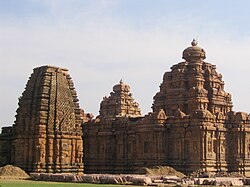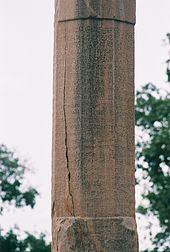Vikramaditya II
| Vikramaditya II | |
|---|---|
| Chalukya king | |
| Reign | c. 733 – c. 744 CE |
| Predecessor | Chalukyas of Vatapi |
| Father | Vijayaditya |
| Chalukya dynasties |
|---|

Vikramaditya II (reigned 733 – 744 CE) was the son of King
Wars against Pallavas



Unlike King Vijayaditya, who had ruled till a very old age in a long and peaceful reign of four decades, Vikramaditya II's inscriptions seem to convey an impatience for war. From those inscriptions, historians feel that he nursed a grudge against the
Immediately after coming to power, Vikramaditya II saw an opportunity in the ensuing civil war in Kanchipuram and espoused the cause of Chitramaya, against that of Nandivarma II.
Vikramaditya again invaded the Pallava kingdom after 734, aided by the faithful ally, the Western Ganga King Sripurusha, who joined the Chalukyas in this expedition. The earliest mention of this invasion is in the Narwan plates issued on 21 December 741 or 742. The Pallava King Nandivarman was a 13-year-old boy who nevertheless made a valiant but futile attempt to face the invasion. The Pallava king fled Kanchipuram into exile, leaving behind all his regal attributes which included among other things, a prestigious musical drum (katumukha), a musical instrument (samudraghosa) and a mace. Many of his war elephants, a large quantity of precious stones and gold fell into the hands of the victorious Chalukya monarch.[6]
The road to Kanchipuram lay open and Vikramaditya II entered the city victorious. He ensured that the residents of the city were not harmed nor were the beautiful monuments destroyed (from inscription - Kanchim avinasya pravisya). The bounties of war were also returned.
He overran the kingdoms of
Rule
Vikramaditya II donated 50 nivartanas of land for maintenance of charity house of Dhavala-Jinalaya at Lakshmeshwara, Dharwad district in 735 CE.[10]
References
Citations
- ^ a b c Ramesh (1984), p.156
- ^ a b c Kamath (2001), p.63
- ^ Nath sen, Sailendra (1999). Ancient Indian History and Civilization. Routledge. p. 395.
- ^ Ramesh (1984), p.157
- ^ Sastri (1955), p.139
- ^ a b Ramesh (1984), p.158
- ^ a b Sastri (1955), p.140
- ^ a b Ramesh (1984), p.159
- ^ Ramesh (1984), p.160
- ^ Ram Bhushan Prasad Singh 2008, p. 83.
Sources
- Suryanath U. Kamat (2001). Concise History of Karnataka, MCC, Bangalore (Reprinted 2002).
- Majumdar, R.C. (2003) [1952]. Ancient India. New Delhi: Motilal Banarsidass. ISBN 81-208-0436-8.
- K.V. Ramesh, Chalukyas of Vatapi, 1984, Agam Kala Prakashan, Delhi
- Nilakanta Sastri, K.A. (1955). A History of South India, OUP, New Delhi (Reprinted 2002).
- Singh, Ram Bhushan Prasad (2008) [1975], Jainism in Early Medieval Karnataka, ISBN 978-81-208-3323-4
- South Indian Inscriptions - http://www.whatisindia.com/inscriptions/
- History of Karnataka, Mr. Arthikaje
